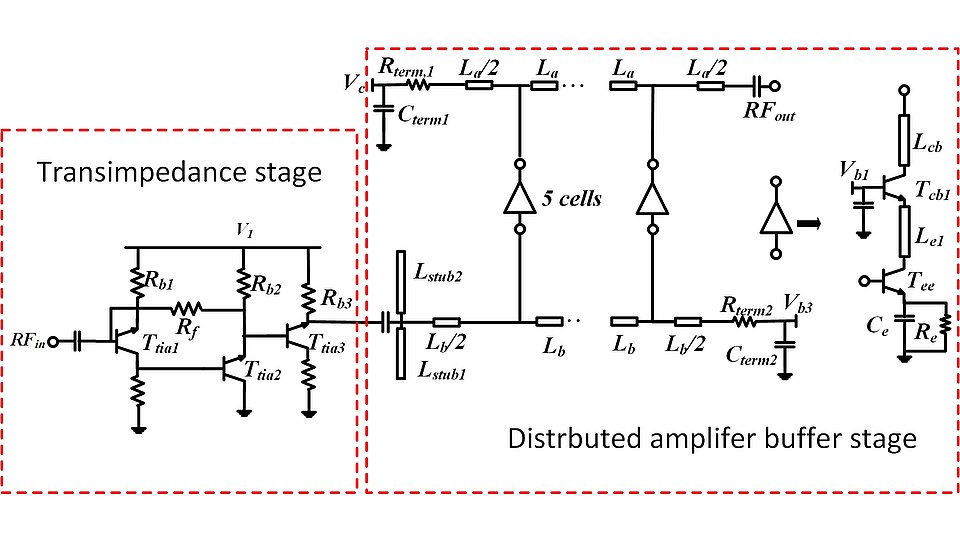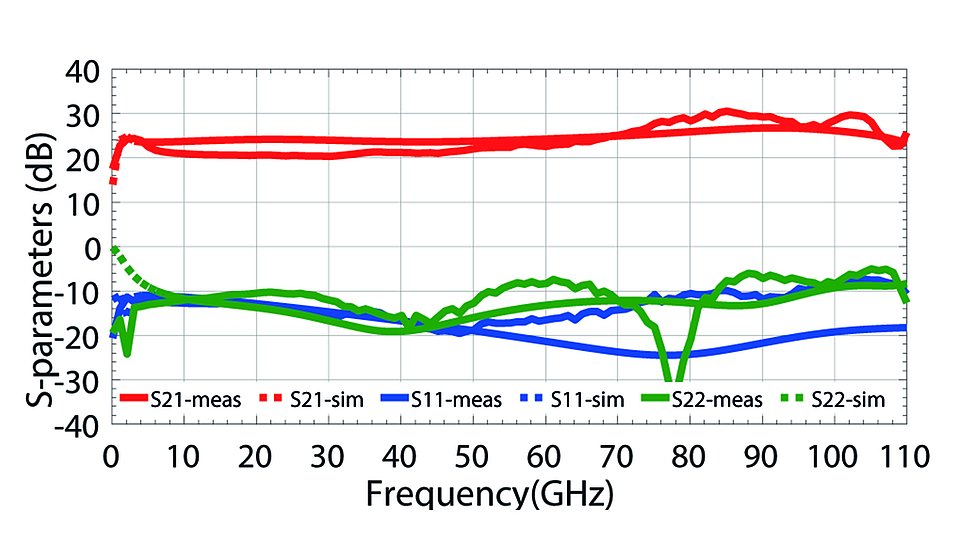Highly linear MMIC amplifiers with beyond 1.75 THz gain-bandwidth product
Data transceiver systems have reached data rates beyond 100 Gbps for a single channel, which requires ultra-wideband amplifiers for both wireless and wireline applications. Typical figures of merits for such amplifiers are a high gain-bandwidth product (GBP), high linearity, low deviation from linear phase and high efficiency leading to low DC power consumption.
The FBH has reported on distributed ultra-wideband amplifier topologies that are based on its proprietary InP DHBT technology [1-3]. These amplifiers show highly promising characteristics with regard to the features mentioned. Using a transistor with ft, fmax values of 350/450 GHz and a dual-stage amplifier subsystem, a measured GBP of >1.75 THz has been obtained with a gain of 24 dB over a frequency from DC to more than 110 GHz. The highest reported GBP is achieved using a transimpedance gain stage followed by a distributed amplifier, as illustrated in Fig. 1. The transimpedance stage serves as a versatile input stage, which can be slightly redesigned when used in optical transceivers to match the photodiode impedance or in measurement systems using 50 Ω characteristic impedance.
A key parameter to obtain this breakthrough is the incorporation of a diamond heat spreader with the InP MMIC amplifier, which drastically reduces the thermal load on the transistor. Instead of a typical heat up to 80°C, the device with the diamond heat spreader reaches only 62°C above base-plate.
This dual-stage high-gain amplifier MMIC consists of a high-gain transimpedance stage with a gain of 12 dBm, a bandwidth of 130 GHz and a power buffer stage in the form of a distributed amplifier with a simulated gain of 14 dB and a large-signal P1dB >10 dBm and >110 GHz bandwidth [4]. The distributed amplifier consists of 5 equally spaced cells, each containing a cascode-stacked transistor with reduced Miller capacitance and higher bandwidth.
The small-signal performance is presented in Fig. 2 and compared to simulations, demonstrating the maturity of the PDK for this process. The overall small-signal gain varies between 21 - 30 dB with an average value of 24 dB. The deviation from the linear phase is within ±15° from near DC up to 80 GHz. The large-signal measurements of the subsystem were carried out using a PNA-X network analyzer, using its two-tone capabilities with a frequency separation of 1 MHz. The output referred third-order intercept point varies between 20 to 24 dBm, which is a very high value for this class of circuits.
This work has been carried out within the TERAWAY project that has received funding from the European Union’s Horizon 2020 Research and Innovation Programme under G.A No 871668 and is an initiative of the Photonics Public Private Partnership. Part of the work was funded by the German BMBF within the framework of "Research Fab Microelectronics (FMD)" under ref. 16FMD02.
Publications:
[1] T. Shivan et al., “A Highly Efficient Ultrawideband Traveling-Wave Amplifier in InP DHBT Technology,” IEEE Microw. Wireless Compon. Lett., vol. 28, no. 11, pp. 1029–1031, Nov. 2018.
[2] T. Shivan et al., “Performance Analysis of a Low-Noise, Highly Linear Distributed Amplifier in 500-nm InP/InGaAs DHBT Technology,” IEEE Trans. Microw. Theory Techn., Early Access, Nov. 2019.
[3] T. Shivan et al., "High Output Power Ultra-Wideband Distributed Amplifier in InP DHBT Technology Using Diamond Heat Spreader," 2020 IEEE/MTT-S International Microwave Symposium (IMS), Los Angeles, CA, USA, 2020, pp. 401-404, doi: 10.1109/IMS30576.2020.9223893.
[4] T. Shivan et al., "A Highly Linear Dual Stage Amplifier with Beyond 1.75 THz Gain-Bandwidth-Product," 2021 IEEE/MTT-S International Microwave Symposium (IMS), 2021.

